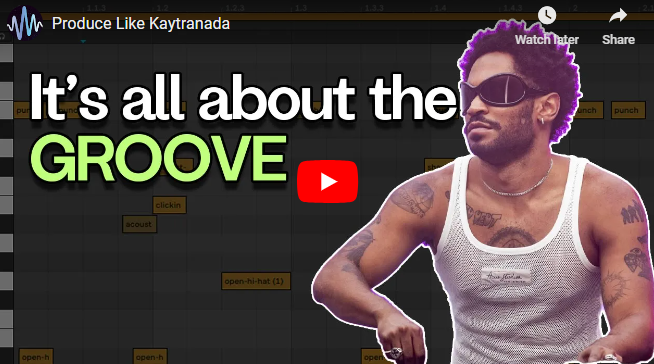In this post, we're going to break down Kaytranada's music making style. His specific sound is known for a unique use of organic drum patterns, funky chord progressions, and layered basslines. We will show you how to incorporate these techniques into your own tracks.
Make sure to also check out our video that shows you exactly how to do this using Ableton Live.
Kaytranada’s Unique Music Production Style
Blending Hip-Hop and House Music
Kaytranada’s music stands out because of the way he blends hip-hop and house . His tracks have the rhythmic complexity of hip-hop beats combined with the energy of house music. This is what sets him apart from other producers.
- Try this: exercise analyzing and adapting elements of Kaytranada’s music. This look at your music making from a new perspective.
Organic Drum Patterns and Groovy Basslines
Kaytranada’s production is marked by organic drum patterns and groovy basslines. These elements are placed in a way that make his tracks both complex and accessible.
- Balance of Simplicity and Complexity: Each sound in Kaytranada’s tracks contributes to an organic movement, achieving a perfect balance between simplicity and complexity.
- Synthesized Sounds and Presets: Using synthesized sounds and presets from Ableton, Kaytranada crafts a cohesive and unique sound rooted in music theory.
- Melodic and Percussive Basslines: The interplay between bass and drums is crucial in creating a groovy, danceable track.
Techniques to Emulate Kaytranada’s Style
Unquantized Notes for a Laid-Back Vibe
One technique that stands out in Kaytranada’s production is the use of unquantized notes. This approach involves deliberately offsetting notes to create a laid-back vibe, adding to the organic feel of the music.
- Offset Laid-Back Vibe: Incorporating unquantized notes can add a human touch to your tracks, making them feel more natural and less mechanical.
- Complementary Sound: This technique works well with the overall sound of the track, enhancing its groove and danceability.
Simplifying the Production Process
Kaytranada often simplifies his production process by making small changes to duplicate loops and adding unique elements like vocal samples. This method allows for experimentation and variation without overcomplicating the production.
- Duplicate Loops and Small Changes: By making small adjustments to loops, you can create a variety of sounds without overwhelming the production.
- Vocal Samples and Transpositions: Adding vocal samples and experimenting with different modes and transpositions can help create a distinct sound.
Utilizing Ableton’s Session View
Ableton’s session view is a powerful tool that Kaytranada uses to play with different elements in a track. This feature makes things easier for you via real-time experiments and arrangement.
- Session View for Experimentation: Use Ableton’s session view to test elements and arrangements in your track.
- Valuable Tool for Production: This feature is particularly useful for producers looking to experiment with various sounds and arrangements.
Key Takeaways
Kaytranada’s music production style offers valuable lessons for producers. By analyzing and incorporating his techniques, you can add a different touch to make your own unique sounds.
- Blend Genres Creatively: Don’t be afraid to mix different genres to create a unique sound.
- Focus on Groove: Pay attention to the interplay between bass and drums to create a groovy, danceable track.
- Experiment with Unquantized Notes: Add a human touch to your tracks by incorporating unquantized notes.
- Simplify Your Process: Make small changes to loops and experiment with vocal samples and transpositions.
- Leverage Ableton’s Tools: Utilize Ableton’s session view to experiment with different elements and arrangements.
Final Words
Kaytranada’s distinctive style demonstrates you always have to experiment in music production. To create a unique and danceable sound, experiment with genre blending, focus on the groove of your bass and drums, and incorporate unquantized notes for a human touch. Simplify your process by making small changes to loops and experimenting with samples. Use Ableton's session view to explore different arrangements and elements.







Comments